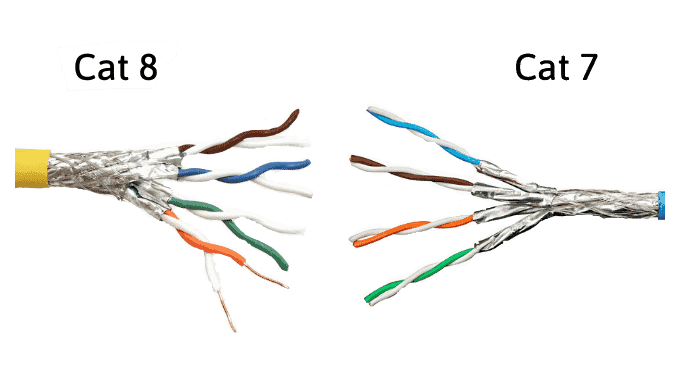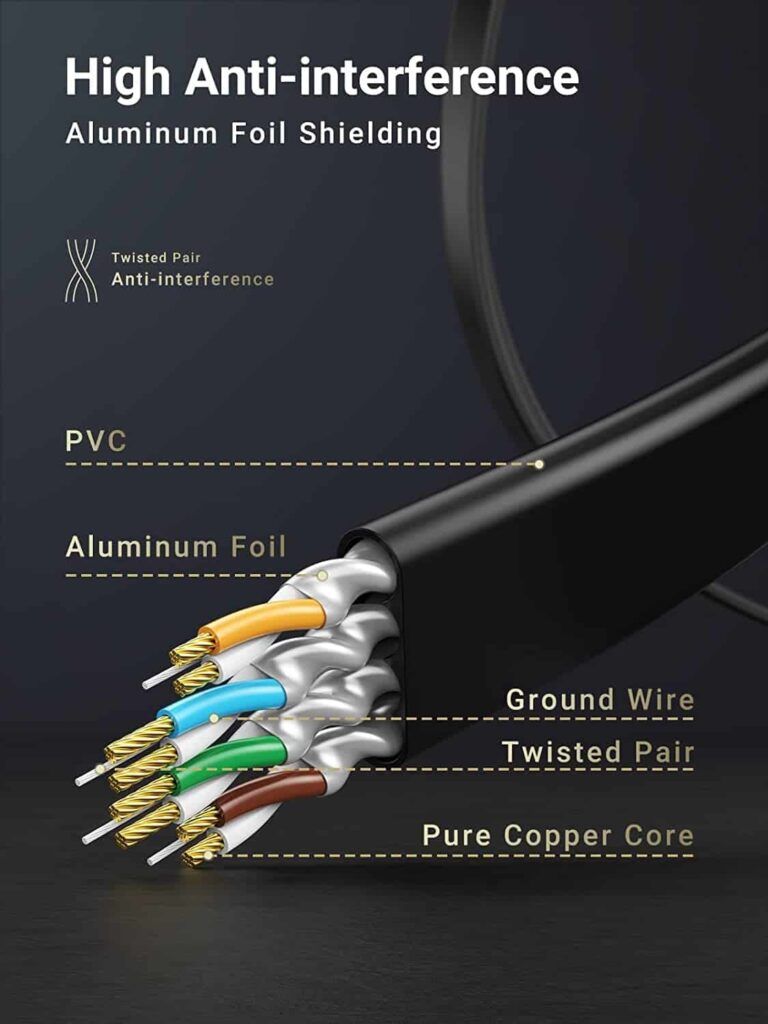Cat 7 vs Cat 8 Ethernet Cable: Who Wins in 2025?

The major difference between Cat 7 and Cat 8 ethernet cables is in terms of the distance they can travel with faster speeds and at what operating frequency.

Specifically, Cat 8 cables can deliver up to 40 Gbps at a distance of up to 30 meters operating at a higher frequency of 2000 MHz. Cat 7 cables, on the other hand, delivers the same speed until 10 meters, operating at 600 MHz.
Cat 8 works with its official predecessor Cat 6a cable networks. Despite being unrecognized by TIA, the Cat 7a are compatible with Cat 5e, 6 & 6a networks. So, choosing between Cat 8 and Cat 7 depends on the speeds and transmission range.
Key Takeaway: High-speed data centers which rely on ultra-fast internet will benefit from the capacity & reliability of Cat 8. But for commercial facilities, the transmission range and cost advantage of Cat 7 become the game-changer.
Cat 8 vs Cat 7: Key Differences
Cat 7 vs Cat 8: Detailed Comparison
Don’t rule out the performance of Cat 7 ethernet cable, which operates at 600 MHz delivering quality output for longer transmissions.
The class 1 Cat 8 cables (RJ-45 type connectors) are backward compatible with Cat 6a networks, which makes the upgrade less cumbersome. The class 2 Cat 8 tables are designed with GG45 connectors targeting interoperability with Cat 7 cabling networks.
While the Cat 7 cables, despite the difference in terminating connectors, can work with older Cat 5e, 6, and 6a networks.
The extra shielding in Cat 8 cables, a similar yet slightly improved version of Cat 7 cables, makes it bulkier and difficult to install. But the durability and reduced interference/cross-talk make it worth the hassle if you can afford the cost factor.
The Cat 7 cables lack the official recognition of TIA, while Cat 8 cables are the official successor of Category 6a cables.
What Is Cat 7 Ethernet Cable?

The combination of internal shielding for individual pairs and external shielding makes the Cat 7 more reliable than Cat 6, which relied more on the quality & length of the twisted cable pairs.
Even with a long twist in cables, Cat 7 minimizes interference and delivers a better signal-to-noise ratio with minimal cross-talk, which CAT 8 does even better.
The CAT 7 cable uses the GG45 (non-RJ type) connectors, while Cat 8 and other older versions use the RJ-45 type connectors. The same cables are used to connect a landline phone to the cable modem.
An operating frequency of 600 MHz is a vast improvement for delivering higher speeds of 10 Gbps across a transmission range of 100 meters. The cables seem to provide speeds of 40 Gbps until 10 meters.

Cat 7 vs Cat 7A
Improved upon the CAT 7 design, the CAT 7a ethernet cables operate at a higher frequency, delivering high speeds with a better signal-to-noise ratio and negligible interference.
The higher price, which adds to even higher installation costs, raises serious questions about the necessity to upgrade and a rational justification for the price.
If the marginal performance delivers a competitive advantage to your business, then go for Cat 7a ethernet cabling, otherwise, Cat 7 cables are cost-effective and reliable.
Pros & Cons of Cat 7 Cables
Pros
- Individual shield twisted-pair cabling
- Higher speed capacity
- 100meter transmission range
- Limited crosstalk
- Lower signal-to-noise ratio
Cons
- Higher cost
- Not officially recognized by TIA
What is Cat 8 Ethernet Cable?
The Cat 8 Ethernet cables are bulkier, and it’s hard to install and bend compared to Cat 7 cables, owing to the extra shielding. That makes them even more reliable in delivering better signal quality and interference.
They are geared to deliver higher speeds of up to 40 Gbps within a transmission range of 30 meters. The speeds drop if the range increases any further. The higher speeds are possible, credit to the higher operating frequency of 2000 MHz.
Unlike the Cat 7, the Cat 8 cables work with two classes of connectors. The class 1 RJ45 connector is backward compatible with Cat 6a cables, while the class 2 cables use GG45 (non-RJ45 connectors) aiming to inter-operate with Cat 7 cables.
Pros & Cons of Cat 8
Pros
- 40 Gbps speeds
- Insignificant levels of interference & noise
- Available with 2 types of connectors
- Operating at a higher frequency
- Durable
Cons
- Expensive
- Bulkier & difficult to install
Who Should Use Cat 7 Cable?
If you want to power your smart home with reliable wired internet, go for Category 7 cables. The shielded cables protect your network from external interference, deliver high speeds, and last over 15 years.
Service providers designing indoor networking solutions for commercial facilities & apartment complexes can use the higher transmission range, reliability, and cost factor of the Cat 7 cables.
Who Should Use Cat 8 Cable?
The high acquisition and installation cost makes the Cat 8 cables financially viable for high-speed data centers, cloud servers, enterprise-level servers, and Ethernet switches.
Frequently Asked Questions
Cat 7 vs Cat 8 for gaming: Which One?
Regarding communicating frequency, speed limits, and minimal interference, Cat 8 Ethernet cables are superior performers for data-intensive gaming.
Cat 7 cable vs Cat 8 cable: Which is better for streaming?
Solely based on speed capacity and performance, Cat 8 ethernet cables are suitable for heavy streaming activities.
Is Cat 8 backward compatible?
Cat 8 is the official successor of Cat 6a cables and is backward compatible with the Cat 6a cabling network. They can work with older Cat 6 and Cat 5e cable networks that use RJ-45 connectors but are officially not recommended.
Is Cat 8 the best ethernet cable?
It is the latest standard of ethernet cable as officially recognized by TIA. Their speed, reliability, durability, and minimal signal-to-noise performance make it one of the quality ethernet cables money can buy. The quality comes at a higher cost.
Do I need a Cat 8 ethernet cable?
For most homes, a Cat 8 Ethernet cable can be overkill. The speeds available for home networks are far below those supported by these cables, which rules out an upgrade to Cat 8. The jump in cost makes it viable for businesses and commercial establishments, where speed is the differentiating factor.
Will Cat 8 work with my router?
Cat 8 cable uses an RJ-45 type connector, which makes it compatible with most recent routers. However, your router or home networking equipment doesn’t operate on speed levels far below Cat 8 speeds. Cat 6 or 6a ethernet cables should be more than sufficient to pair up with your router.
Conclusion
That was all about comparing Cat 7 and Cat 8 cables. To summarize, the cost factor is associated with a marginal competitive advantage, where the performance of Cat 8 offers a superior advantage. Otherwise, Cat 7 ethernet cable finds a sweet spot with a balance between cost, performance, and reliability.
